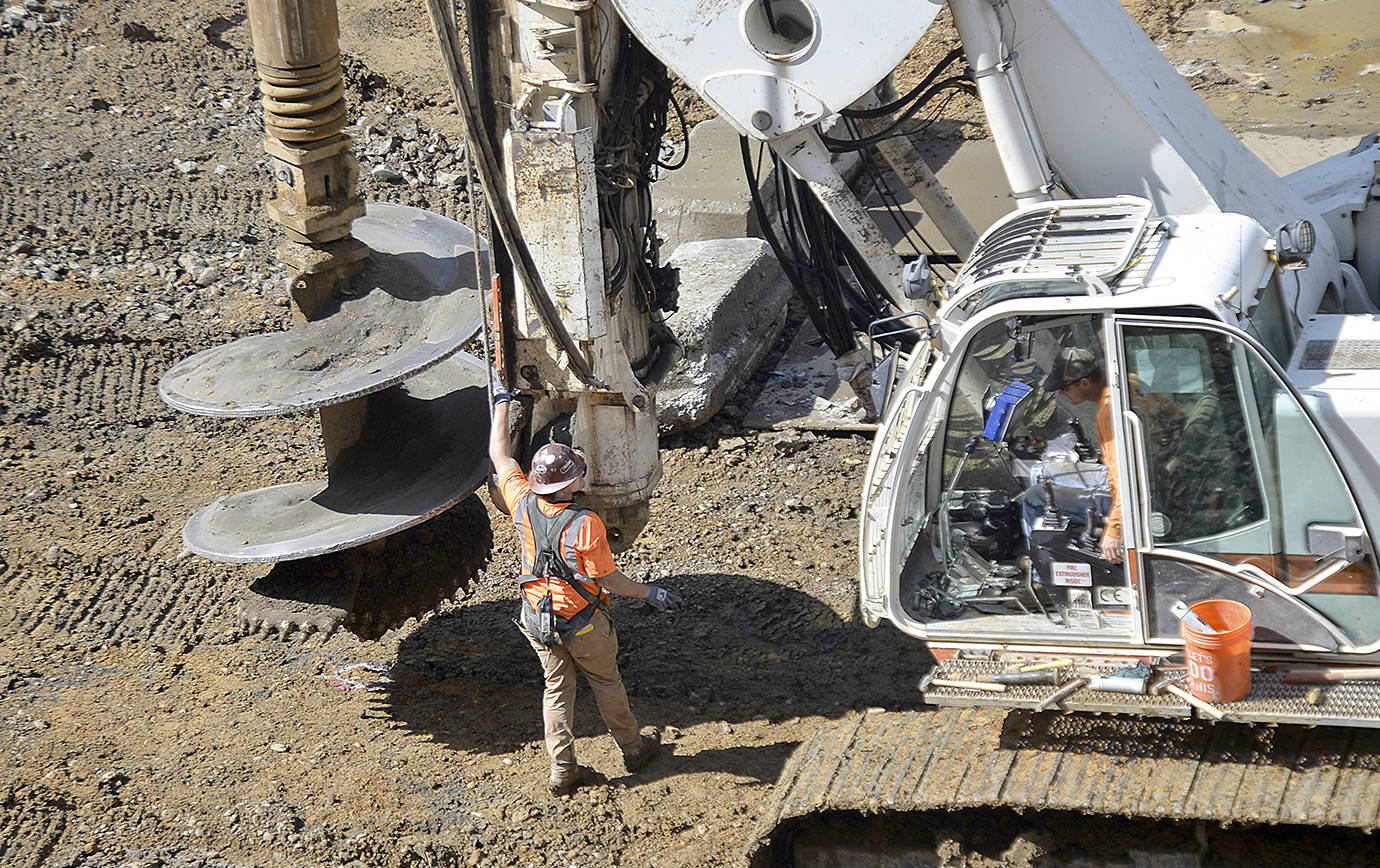Precision work, and a lot of it, is going into the state Department of Transportation’s latest and more permanent fix for the slide-prone section of U.S. 101 around milepost 79 on Cosi Hill.
This fix consists of drilling 575 shafts, 6 feet in diameter and ranging from 20-50 feet deep, and filling them with quarry spalls — rock about 6-9 inches in diameter — on the west bank below the roadway just south of Cosmopolis.
A visit to the site July 18 had crews from Rognlin’s Inc. preparing to drill shaft 14, still more or less on schedule for the 125 working days allowed by the contract, despite very heavy rains the day before.
The bank to the west of the roadway has been cut down to a flat surface, where two cranes are on site, one to drill the shafts, another to lift a piece of equipment called King Kong atop the metal shafts. King Kong then vibrates, shaking the shafts to the proper depth as determined by project engineers.
Project Engineer John Romero broke it down like this:
A total of 31,170 cubic yards of roadway excavation and slide material will be hauled out of the site during construction, which is expected to be completed in the fall of 2020. That’s about 3,100 dump trucks full of dirt, clay, rock and other material removed from the site.
A total of 19,598 feet of shafts dug. That’s 3.7 miles worth.
Shaft excavation, the material dug out of the shafts themselves, adds up to 20,530 cubic yards, around 2,100 dump trucks full.
The quarry spalls — the rock used to fill the shafts — will take the same number of dump trucks as the excavation material to deliver, a total weight of 28,740 tons.
Project engineers have carefully designed the exact location and depth of each individual shaft. Spots are marked on the ground with a 6-inch square. Romero said each hole must be centered within that 6-inch square.
Each shaft must be drilled straight, with less than a 2 percent from perpendicular margin of error, said Romero. To accomplish this, the large drill used to cut the holes is carefully positioned above each marked spot. A worker uses a level to make sure the drill is positioned as straight as possible before drilling begins.
As the crane is positioned for drilling, large metal plates are placed next to the crane. There, the material drilled out of each shaft is placed, making it easier for it to be scooped up and moved to the south end of the construction site, near the top of Cosi Hill, for removal.
All the while, dump trucks with the fill rock arrive at the south end of the site. After the rock is dropped off, the dump trucks are loaded with the shaft excavation material for removal.
Once a metal shaft is inserted into the excavated hole, King Kong goes to work, shaking the ground as it tamps the metal shaft to the desired depth. The metal shaft is filled with rock. After the rock has settled the metal shaft is removed.
History of the site
As Romero explained it, the Department of Transportation conducted initial slide mitigation efforts in 1994. Additional stabilization measures were implemented in 1998, including trench drains and vertical and horizontal drains, “and still the issues persisted.”
The movement of the earth underneath the roadway began again in May 2011, which continued until 2016 when geotechnical drilling began. Romero said the state started drawing up plans for the rock-filled shaft stabilization option as funding was secured.
The contract for the project was awarded to Rognlin’s this past May. The total construction costs are just shy of $8.25 million. Work officially started June 17 and will continue until the project is completed in fall 2020.
Romero said the Department of Transportation lessened the impact on drivers during the construction process with a 5-day complete closure of the roadway starting June 17. During that time, crews constructed an additional lane to the east of the roadway, leaving two lanes, one in each direction, to allow for the flow of traffic during the process.
When complete, the roadway will look much as it did before the slides took out the southbound passing lane. There will be one lane going north into Cosmopolis, and the two lanes heading up toward the top of the hill southbound.
As the construction goes on largely out of site the speed limit through the work zone is reduced to 25 mph. Romero and Department of Transportation spokeswoman Christina Werner noted how few of the cars that passed by July 18 were honoring the reduced speed limit.
“This is an active construction site,” said Werner. With the dump truck traffic entering and leaving the work site near a corner at the top of Cosi Hill and contractor and Department of Transportation workers entering and leaving the site, she said it’s important for their safety, and the safety of the drivers, to observe the reduced speed limit.


